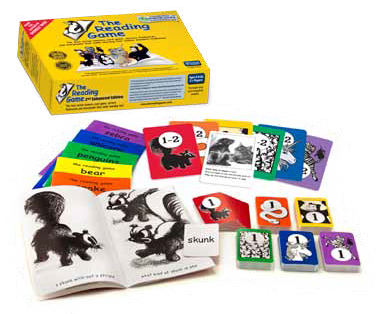The Reading Game teaches beginning reading strictly through sight words. This boxed set consists of an eight-page "The Reading Game Rules and Guide" and six reader sets. Each reader set is made up of a 32-page reader, word cards (60 in each set), and "captioned picture flashcards" (3 in each set).
The Reading Game is well designed. It comes in a sturdy box with divided sections that hold the opened decks of word cards. (It’s a real time saver when I don’t have to use rubber bands or baggies to contain the card decks!)
The six readers are titled Skunk, Snake, Bear, Penguins, Unicorn, and Zebra. Each reader set teaches 30 new words, many of them drawn from Dolch and other high-frequency word lists. So children will learn a total of 180 words in The Reading Game, and they will learn to read complete sentences.
The first set teaches words such as they, this, cat, play, do, and what. Each set gradually adds some words that are more difficult. The third set teaches words such as after, are, awake, his, honey, know, and where. The sixth set introduces words such as alphabet, dolphin, should, goes, goose, hen, loose, and vulture.
Children are not expected to have learned phonics or other reading skills before using The Reading Game, although they should be aware that letters have sounds and are used to form words. The readers and their associated cards must be used in order since the words taught in each reader set are incorporated in each subsequent reader, along with the 30 new words that will be introduced.
A tutor (or parent) needs to work with the student, and that work begins with the deck of word cards for Skunk. Each word-card deck (60 cards) has two of each card. The reverse side of each card shows the animal and a number from one to six, so it's easy to pick out the cards you need. The 30 new words will be introduced five at a time.
To begin, you will select the first ten skunk cards─two cards each for the first five words─and lay them out upside down to play a Memory game. This game helps students begin to develop word recognition, the basis of sight-reading. Whenever one of you claims a matching pair, you or your child will say the words on the cards. Of course, you will have to help the child at first with new words. You will keep playing Memory until the child has mastered the five words.
The next five words are introduced in the same way. After ten words have been learned, you show the child the first captioned picture flashcard and have them read it. Each of these cards has a photo with sentences underneath it that are made with words that the student has learned thus far. This process is repeated until all 30 words are mastered. By the way, the sentences on the captioned picture flashcards also serve as an introduction to sentence structure with a capital at the beginning and a period, question mark, or exclamation point at the end. (You will probably need to explain this to your child.)
Once students can read the words and sentences, they will read the first reader. The readers are illustrated with black-and-white drawings. The style of the drawings is unusual for readers. The drawings often have dark shading and occasionally include ferocious-looking animals, so they seem a little ominous to me for beginning readers.
All of the six reader sets work in the same fashion: they introduce new words, then they review all previously learned words as children read the sentences and the readers.
The website has free downloadable files with six pretests and six posttests that can be used with each reader set. There’s a class recording sheet for keeping track of student progress if that’s useful to you. There is a “Test Sentence Assessment” file that has sentences somewhat similar to those on the captioned picture cards, but with slightly different wording and no capitalization at the beginning of sentences or punctuation at the end. You might use these as a way to teach your child how to read words when they are strung together, then introduce students to the properly-formatted sentences on the captioned picture card, but it’s optional.
Even though The Reading Game was designed as a way to teach beginning reading using sight words, I think it would also work well after a child has begun to learn to read with a phonics method. It would then provide review for some words a student has already learned, and it would teach or reinforce sight words along with some advanced phonetic words that a student might not yet have learned.









